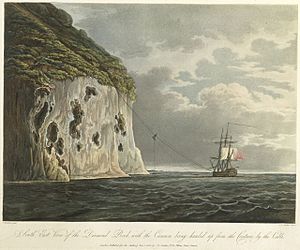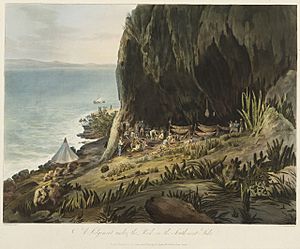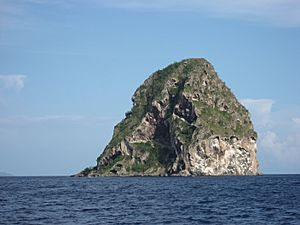Battle of Diamond Rock facts for kids
Quick facts for kids Battle of Diamond Rock |
|||||||
|---|---|---|---|---|---|---|---|
| Part of the Trafalgar campaign of the War of the Third Coalition | |||||||
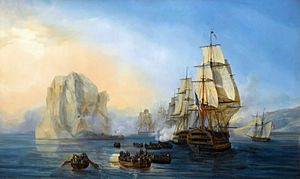 Taking of the rock Le Diamant, near Martinique, 2 June 1805, Auguste Mayer |
|||||||
|
|||||||
| Belligerents | |||||||
| Commanders and leaders | |||||||
| Strength | |||||||
| 2 ships of the line 1 frigate 1 corvette 1 schooner 11 gunboats |
1 stone frigate | ||||||
| Casualties and losses | |||||||
| 50 killed and wounded 5 gunboats sunk |
2 killed 1 wounded 104 captured |
||||||
The Battle of Diamond Rock was a fight during the Napoleonic Wars. It happened between May 31 and June 2, 1805. A combined force of French and Spanish ships, led by Captain Julien Cosmao, attacked Diamond Rock. This rock is located at the entrance to the bay leading to Fort-de-France in Martinique. British forces had taken control of the rock more than a year earlier.
The French on Martinique had tried but failed to remove the British from this important rock. The British soldiers there could control who entered Fort-de-France Bay. They fired cannons from the rock at any ships trying to pass. In May 1805, a large French and Spanish fleet arrived. This changed the situation. The French commander, Pierre de Villeneuve, had orders to attack British areas in the Caribbean. But he waited at Martinique for clearer instructions. Finally, he agreed to attack the British on Diamond Rock. A group of French and Spanish ships was sent to capture it.
The British defenders on the rock were already low on water. They held out for several days. The French had forgotten to bring ladders, so they couldn't climb the steep sides of the rock easily. The British, running out of water and ammunition, eventually surrendered after many days of fighting. Because Diamond Rock was officially considered a British Royal Navy ship, its commander, Lieutenant Maurice, faced a court-martial (a military trial). This was standard for any captain who lost their ship. However, he was found innocent and honored for his brave defense.
Contents
Why Was Diamond Rock Important?
Fortifying Diamond Rock
In January 1804, Commodore Samuel Hood ordered Diamond Rock to be made into a fort. Hood was working in the West Indies, protecting British ships from French privateers. These privateers were like pirates working for the French government. They sailed from French naval bases in Guadeloupe and Martinique. They had captured many valuable British goods.
Hood decided to block off Martinique. This would stop the privateers and cut off supplies to the French soldiers there. He noticed that if the British controlled Diamond Rock, they could easily control ships trying to reach Fort-de-France. The currents around the island forced ships to pass close to the rock.
Hood explored Diamond Rock and thought it was very easy to defend. The only place to land was on its western side. He wrote that "thirty riflemen will keep the hill against ten thousand." On January 7, 1804, a group of men landed from Hood's ship, HMS Centaur. They were led by Lieutenant James Wilkes Maurice. They quickly set up a small fort at the landing spot. They also built workshops in a cave at the base of the rock.
They used ladders and ropes to climb the steep sides of the rock. At the top, they made living areas in small caves. They even blasted a space to set up a cannon battery. In February, cannons were moved from Centaur to the rock. Two 24-pounder cannons were placed near sea level. Another 24-pounder was halfway up. Two 18-pounders were placed at the very top. The men also had boats, one with a cannon, to stop enemy ships. It was very hard work to pull the heavy cannons up the rock.
French Response to the Fort
The French did not act quickly while the British were building the fort. The governor of Martinique, Louis Thomas Villaret de Joyeuse, ordered a road and a battery to be built across from the rock. But the British were warned by local people who supported them. A British group went ashore and captured the French engineer building the battery. After more British raids, the French stopped building their battery.
HM Fort Diamond - A Ship Made of Stone
By early February, the cannons were ready. The 18-pounders at the top could control the passage between the rock and the island. This forced ships to avoid that channel. The winds and currents then made it hard for these ships to enter the bay.
On February 7, Hood made the rock an official British naval post. He told the Admiralty that he had made the rock a sloop (a type of warship). He named it Fort Diamond. Lieutenant Maurice was made its commander. Diamond Rock was treated like a captured enemy ship. It was even called the "Sloop Diamond Rock." The cannons also got names. The two 18-pounders at the top were "Fort Diamond" or "Diamond Battery." The 24-pounder halfway up was "Hood's Battery."
Life on the Rock
Lieutenant Maurice commanded about 100 men on the rock. They had officers just like a regular warship, including a doctor and a supply officer. A hospital was set up. Food, gunpowder, and ammunition were brought to the rock by boat. First, from Centaur, then from Martinique, bought from friendly locals. Water also had to be brought from the island. Large tanks were built to store it. Life on the rock was risky. Men could fall from the heights or be bitten by the fer-de-lance, a dangerous snake living on the rock.
The Battle for Diamond Rock
First French Attack Fails
After the British fort was set up, Commodore Hood left with Centaur. The French saw a chance to attack. Four boats full of soldiers were sent at night. But the strong currents swept them out to sea. They eventually made it back to Martinique. The British only found out about the attempt days later. If the French had attacked during the day, the British could have easily sunk their boats. After this failure, the French did not try to attack the fort from the island again. Maurice and his men then spent their time raiding French ships and stopping trade.
Villeneuve's Fleet Arrives
On May 14, 1805, a large French fleet arrived in Fort-de-France Bay. This was 17 months after the British took the rock. The fleet, led by Pierre de Villeneuve, briefly exchanged fire with the British on Diamond Rock as they passed. Over the next few days, Spanish ships joined them, led by Federico Gravina.
On May 16, as the Spanish ship San Rafael came close, the British raised the French flag. This tricked the Spanish ship into coming closer. Then, the British quickly swapped the French flag for the British one and opened fire! This surprised the Spanish. (Using a false flag was a common trick in war back then.)
Soon after, the British found a problem. Their main water tank, which held a month's supply, had cracked from small earthquakes. The cannon fire made the crack worse. They had only two weeks of water left. New supplies couldn't be brought in because French ships began to block the rock.
The combined French and Spanish fleet had many soldiers. Napoleon wanted them to attack British areas in the Caribbean. But Villeneuve felt his orders were unclear. He stayed at Fort-de-France, hoping another French fleet would join him. He didn't know that fleet was stuck in France. For two weeks, Villeneuve waited. Finally, the governor of Martinique convinced him to use his forces to capture Diamond Rock. Villeneuve gave Captain Julien Cosmao command of the attack. Cosmao was to take two large warships, a frigate, a corvette, a schooner, eleven gunboats, and 300 to 400 soldiers.
The Final Attack
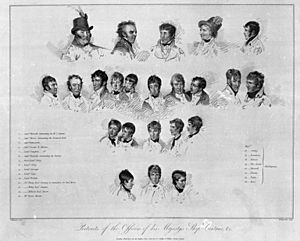
The French and Spanish ships left on May 29. But bad winds meant they couldn't attack until May 31. Lieutenant Maurice saw how strong the French force was. He decided it was impossible to hold the lower parts of the rock. So, he disabled the cannons there, sank his small boat, and moved his men to defend the higher levels.
Four Spanish gunboats helped in the attack. A Spanish gunboat was the first to land soldiers on the rock, even under British fire. Cosmao began a heavy bombardment. The French soldiers fought their way onto the landing area. They lost three gunboats and two rowing boats full of soldiers. However, the attackers had forgotten to bring any ladders. They could not climb the steep sides of the rock. So, they had to surround the British forces on the upper levels.
By June 2, the British were almost out of ammunition. Their water supplies were critically low. Maurice decided to talk about surrendering. At 4 PM, a white flag was raised. A French officer came to offer terms. By 5 PM, Maurice agreed to surrender Diamond Rock. The British officers could keep their swords. The men would stay under their officers' command. They would be taken to Fort-de-France and then sent back to a British area.
The British had two men killed and one wounded in the battle. French losses were harder to count. Maurice thought about 70 French soldiers were killed or wounded. The French commander estimated 50. The British had also sunk five large boats. Maurice and his men left the rock on June 6. They were taken aboard the French ships Pluton and Berwick.
What Happened Next?
Maurice returned to Barbados by June 6. He sent a letter to Admiral Horatio Nelson, who was in the Caribbean looking for Villeneuve's fleet. Maurice explained that Diamond Rock had to surrender because they ran out of ammunition and water. He reported their low losses and the higher French losses.
Naval rules at the time meant that any commander who lost their ship had to face a court-martial (a military trial). So, Maurice had a trial on June 24. He was honorably found innocent. The court said that Captain Maurice and his men did everything they could to defend the rock against a much stronger force. They only surrendered when they had no water or ammunition left.
Villeneuve had recaptured the rock. But on the day the attack started, a French ship arrived with new orders from Napoleon. Villeneuve was told to attack British areas, then return to Europe. But by now, his supplies were so low that he could only attack smaller British islands.
The Spanish commander, Don Federico Gravina, became unhappy with the French. He wanted to invade Trinidad, which the British had taken from Spain. Villeneuve left Fort-de-France on June 5. On June 7, two French ships saw a group of 16 British merchant ships. Villeneuve ordered his fleet to chase them. The Spanish ship Argonauta and the two French ships captured fifteen of the sixteen merchant ships. These ships were carrying sugar, rum, coffee, and other goods.
From these captured ships, Villeneuve learned that Nelson had arrived in the West Indies, chasing him. Shocked, Villeneuve stopped his plans to raid British colonies. He immediately prepared to sail back to Europe. The fleet left on June 11. One of the French army officers with the fleet, General Honoré Charles Reille, wrote: "We have been masters of the sea for three weeks... and have not been able to attack a single island."
The capture of Diamond Rock and the seizing of 15 merchant ships were the only successes for the combined fleet during their time in the Caribbean. Diamond Rock stayed in French hands until the British captured Martinique in 1809.
See also
 In Spanish: Batalla de la roca del Diamante para niños
In Spanish: Batalla de la roca del Diamante para niños


